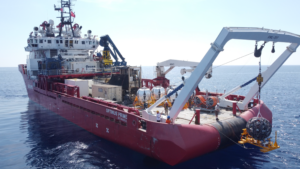In the Italian section of the KM3NeT neutrino telescope, nine new detector lines were placed on the deep sea floor last week. This brings the total in that section to 28.
All new lines are connected to the KM3NeT network at 3.5 kilometers depth and are working properly, said Nikhef researcher Aart Heijboer, physics coordinator of the experiment. ARCA is located in the deep sea about 100 kilometers off the coast of the southeastern tip of Sicily, where KM3NeT’s coastal station is located and the measurement data come in.

ARCA consists of hundreds of meters of lines on the seafloor with dozens of light sensors in waterproof spheres. When a neutrino passes through the water, it creates a trail of light signals that can be seen by the sensors. From the combined sensor signals, the tracks can be mapped and characterized.
The lines are wound up from a lifting vessel on a special spool sunk to the bottom, and unrolled up from there. They are then connected by an unmanned submarine to the grid for electricity and data.
Neutrinos are elementary particles that have almost no mass and hardly interact with other particles. They are created in some particle processes and then usually fly away unseen. This makes it difficult to study them accurately.
KM3NeT is both a telescope and a measuring instrument. The Italian ARCA part is designed to accurately locate the sources of incoming neutrinos in the sky.
In the French part of KM3NeT, called ORCA, 16 detector lines are now in place and active at a depth of 2.5 kilometers. Data arrive there through the station near Toulon. This part of the telescope is primarily intended for research on the behavior of neutrinos themselves. Large parts of ORCA have been assembled in recent years at Nikhef in Amsterdam.
Neutrinos exhibit so-called oscillations, where they constantly change type. The details of this are still under investigation. Nikhef is also closely involved in the analyses of measurements from the neutrino telescope.

